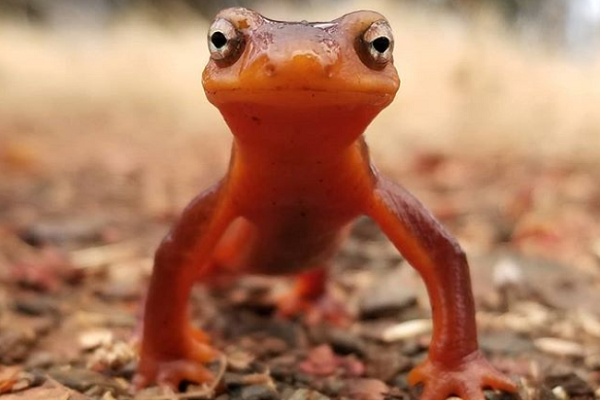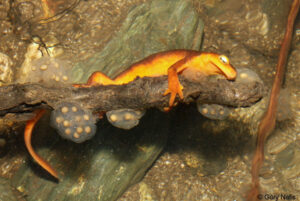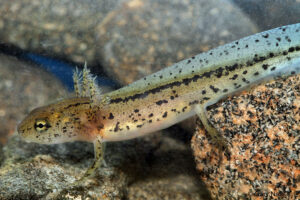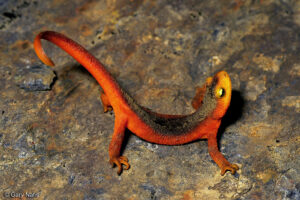Newts of the Yuba
While we all are sheltering in place, many other critters are on the move and enjoying the break from human activities. One animal taking advantage of this is the Sierra newt. Curious about these little guys? Read on to see some of the most frequently asked questions answered.

What’s the difference between a newt and a salamander?
All newts are salamanders! Salamanders are animals in the order Urodela. Within this, there is a family called Salamandridae that houses true newts (confusing terminology, right?). So, all newts are salamanders, but not all salamanders are newts.
I’ve seen newts in the water and on land. Where do they really live?

Newts are both aquatic and terrestrial, depending on their life stage. Nearly all amphibians lay their eggs in water and have an aquatic larval stage. After some time eating and growing in the water, they metamorphose and become terrestrial, returning to the water to breed.
If you want to see a cool video showing newt migrations, check out March of the Newts, a Wild & Scenic featured film from 2019.
https://vimeo.com/288628617
If they live in the water and on land, do they breathe using gills or lungs?

Well, that depends on their life stage. Throughout their lives, newts have three methods of breathing. As larvae, they breathe using external gills. During metamorphosis they lose their gills and develop lungs. As terrestrial adults they breathe using their lungs and partially through their skin, a process called cutaneous respiration.
Sometimes I see newts contort their bodies into weird shapes, almost like a yoga pose. Why do they do this?
While it may look like a circus act, this is actually a defensive pose called the Unken Reflex. Newts of the west coast have aposematic coloration, meaning they have bright colors warning predators they are toxic. However, the newts’ first defense is to be camouflaged, so their bright colors are solely on their bellies. When threatened, newts perform the Unken Reflex, lifting their chin and tail to expose the bright warning colors that say, “Don’t eat me, I’m toxic!”

Are newts edible?
As a follow up from the previous point, DEFINITELY NOT. Newts produce a powerful neurotoxin in their skin called tetrodotoxin that can make you really sick, or even kill you. Even handling a newt and then eating without washing your hands can get the toxin in your body. For your protection, as well as theirs, newts should not be handled.
I’ve never seen a newt in real life! Where can I find one?
Lucky for you, newts are in the midst of their migrations and are easiest to find at this time of year! The best places to look are in or near the pools of creeks and streams. Locally, many individuals have been reported to be seen on Independence Trail.
Newts are really cool. Can we count on them to be around forever?
Unfortunately, Sierra newts are facing similar threats to all west coast newts, with climate change and habitat reduction at the forefront. If you’re curious about how climate change is affecting newts, tune in to Rivers Lab on April 30 where we will discuss a scientific paper about the topic.
Questions not answered here, or just looking to learn more about reptiles and amphibians in general? Tune in Friday, April 10 at 10:00am for SYRCL’s first Ask a Scientist Q&A on Facebook Live. Avid herpetologist Shannon Hedge will be answering all your herp-related questions.
Did you enjoy this post?
Get new SYRCL articles delivered to your inbox by subscribing to our ENews.





Hello, trying to find information on the Red Dog salamander, lizard.